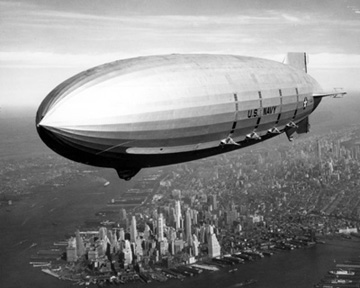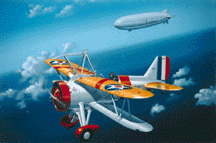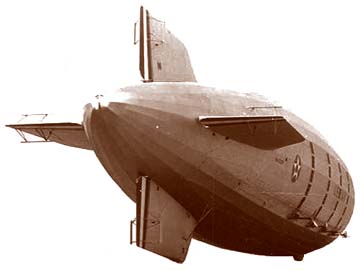| LTA USA
Airships of the U.S. Navy
 Historical
Note Historical
Note
In the era between World Wars I and II, the United
States Navy undertook a project to test and integrate airships
into the operational military fleet. Of the two main types,
rigids and non-rigids, it was the former that garnered the lion's
share of attention in public, private, and political sectors.
Rigids
The rigids, fueled by the enormous popularity of the
commercial Zeppelins, were the largest craft to sail the sky.
These giants -- over three times longer than a jumbo jet --
inspired a sense of awe in those who saw them. The U.S. Navy
flew four of these giant dirigibles. They were some of the best
airships ever built, including the only practicable aircraft
carriers in the world.
The Z designation applied to ALL USN lighter-than-air
craft. K-ships were ZNPKs for instance, the metalclad
was ZMC-2, etc.
Above photo of ZRS5 Macon over NYC, 9 October
1933, courtesy of the Naval
Institute.
| Designation |
Name |
Manufacturer |
Notes |
| ZR1 |
USS
Shenandoah |
US Navy |
|
| ZR2 |
R-38 |
R.A.W. Bedford |
- British R-38
- Crashed in England before delivery to USN
|
| ZR3 |
USS
Los Angeles |
Luftschiffbau Zeppelin |
- Longest-lived USN rigid. It was disassembled.
|
| ZRS4 |
USS
Akron |
Goodyear-Zeppelin |
- Christened: 8 August 1931
- First flight: 25 September 1931
- Stricken: 30 April 1933
- Total flights: 73
- Total flight hours: 1,695.8
|
| ZRS5 |
USS
Macon |
Goodyear-Zeppelin |
- Christened: 11 March 1933
- First flight: 21 April 1933
- Stricken: 26 February 1935
- Total flights: 54
- Total flight hours: 1,798.2
- Total Gas Volume: 6,850,000 cu ft
- Length: 785 ft
- Max Hull Diameter: 132.9 ft
- Max Speed: 75.6 knots (83 mph)
|

Trapeze
| 
|
ZRS4/5 carried five F9Cs airplanes. "The Men on
the Flying Trapeze" were few in number. Their contribution
to extending the scouting range and promoting the concept
of "the flying carrier" was significant.
Paint scheme: Fuselage and tail unit Navy grey. Wings
silver, upper surface of top wing chrome yellow. Fuselage
band, wing chevron, cowling and engine plate and spats,
white. |
| 
A Curtis F9C, piloted by
Lt. D. Ward Harrigan,
hooks on to the USS Macon's trapeze mechanism. |
F9C Sparrowhawk websites:
Information on F9C Sparrowhawks may be found in these
books:
Peter M. Bowers: Curtiss Aircraft,
1907-1947
Naval Institute Press - 1987
William T. Larkins: US Navy Aircraft, 1921-1941
Orion Books - 1988
Gordon Swanborough & Peter M. Bowers:
United States Navy Aircraft Since 1911
Naval Institute Press - 1990
John Wegg: General Dynamics Aircraft and
their Predecessors
Naval Institute Press - 1990
|
Hybrid
| ZMC-2 |
Metalclad |
Detroit Aircraft Company |
|
Non-Rigids
| 
|
The non-rigids, relatively small compared to their
rigid couisins, were the lta workhorse platforms of
the US Navy. The first was built in 1917 and the last
in 1958. They saw use into the 1960s.
|
| During WWII, the US Navy had a fleet of
over 200 blimps. This figure does not include the numerous
barrage balloons employed in protecting troops as they
swarmed ashore strategic beach heads. Blimps were routinely
used in escourting convoys. Their long-range detection
and reporting of submarines is credited with the safe
passage of Allied ships. |
| Designation |
Manufacturer |
Notes |
| A |
Connecticut Aircraft Company |
|
| B |
Goodyear (9)
Goodrich (5)
Connecticut (2) |
|
| C |
Goodyear/Goodrich |
|
| D |
Goodyear |
|
| E |
Goodyear |
|
| F |
|
|
| G |
|
|
| H |
|
|
| J |
|
|
| K |
Goodyear |
During World War II K-ships patrolled the shipping
lanes off the coasts of North and South America and
escorted 89,000 merchant vessels without the loss of
a single ship. |
| L |
|
|
| ZP2K |
|
|
| ZPG |
|
|
 Naval
Air Stations Naval
Air Stations
|